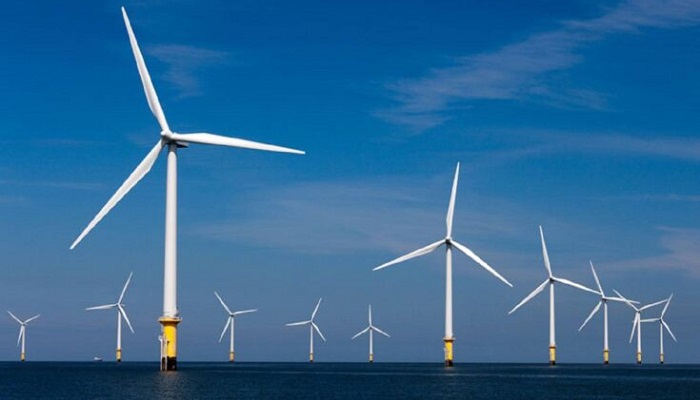The offshore wind industry is experiencing significant growth, with annual installations expected to triple by 2028, increasing from 10.8 gigawatts (GW) in 2023. By 2033, these installations are projected to reach 66 GW. This expansion will elevate the offshore share of new wind power installations from the current 9 percent to at least 25 percent. These insights come from the 2024 Global Offshore Wind Report by the Global Wind Energy Council (GWEC).
In 2023, the offshore wind sector achieved a notable milestone by connecting 11 GW to the grid, representing a 24 percent increase compared to previous years. This achievement marks the second-best year on record for offshore wind despite encountering numerous challenges in key markets.
Investment in Offshore Wind
Investment in the global offshore wind industry has been robust, with Bloomberg NEF reporting that $76.7 billion was invested last year. This occurred despite rising costs, which forced some developers to delay or cancel projects.
Asia, particularly China, is expected to lead the offshore wind market in the next decade. With strong growth prospects in China and emerging markets in Asia, the region’s dominance in offshore wind installations is likely to remain unchallenged. In contrast, the outlook for offshore wind in Europe remains stable and optimistic.
Regional Outlook
In the United States, GWEC Market Intelligence has revised its 2030 offshore wind installation forecast from 25 GW to 15 GW. Despite this downgrade, North America is projected to be the third-largest offshore wind market by 2033, followed by the Pacific region and Latin America.
Floating Wind Developments
Since the release of the Global Offshore Wind Report in 2023, significant progress has been made globally in the development of floating wind technology. However, GWEC Market Intelligence predicts that the commercialization of floating wind will not be achieved until the end of this decade, around 2029 or 2030.
GWEC has also revised its global floating wind forecast, now predicting 8.5 GW to be built globally by 2030, which is 22 percent lower than the previous year’s projection. Their near-term offshore wind market outlook for 2024-2028 is based on a detailed bottom-up approach using their global offshore wind project database.
New Wave of Growth
GWEC’s Global Offshore Wind Report 2024 anticipates a new wave of growth starting in the latter half of this decade, which will increase the global share of new wind installations from 9 percent to at least 25 percent by 2033. Offshore wind is poised to be a crucial component in achieving the 1.5°C pathway. To meet this target, approximately 380 GW of offshore wind capacity needs to be built by 2030.
Growth in 2023
The report highlights that 10.8 GW of new offshore wind capacity was added to the grid in 2023, bringing the total global offshore wind capacity to 75.2 GW by the end of the year. This 24 percent increase over the previous year makes 2023 the second-highest year in offshore wind history.
China continued to lead the world in annual offshore wind developments for the sixth consecutive year, adding 6.3 GW in 2023. This demonstrates China’s ability to maintain stable growth as the country moves toward grid parity. In addition to China, three other markets in Asia commissioned new offshore wind capacity in 2023: Taiwan (China) added 692 megawatts (MW), Japan added 140 MW, and South Korea added 4.2 MW.
Europe’s Record Year
In 2023, Europe achieved a significant milestone by commissioning 3.8 GW of new offshore wind capacity. This was accomplished through 11 wind farms spread across seven different markets. This accounted for a significant portion of the new capacity added globally. The Netherlands led the region with 1.9 GW of new offshore wind capacity commissioned in 2023, followed by the UK (833 MW), France (360 MW), Denmark (344 MW), Germany (257 MW), Norway (35 MW), and Spain (2 MW).
North American Developments
In North America, offshore wind turbines were installed at two utility-scale projects in the United States by the end of 2023, although no offshore turbines were commissioned that year. By the end of 2023, Asia and Europe had 41 GW and 34 GW of offshore wind capacity in operation, respectively. These two regions combined accounted for 99.9 percent of the total global offshore wind capacity.
Technology Hub for Floating Wind
Despite losing its leading position in total installed offshore wind capacity to the Asia-Pacific region, Europe remains the world’s largest market for floating wind technology. Europe continues to be a hub for technological advancements in floating wind turbines and foundations.
Offshore Wind Outside Europe and Asia
Outside Europe and Asia, North America had an operational offshore wind capacity of 42 MW at the close of 2023, with all installations located in the United States. The year 2023 was turbulent for the offshore wind industry on both sides of the Atlantic Ocean, with challenges such as inflation, increased capital costs, and supply chain constraints creating uncertainty in the sector.
Future Outlook
Considering these near-term challenges, GWEC Market Intelligence has downgraded its global offshore wind outlook for total additions in 2024-2028 by 10 percent compared to their 2023 projection. Despite the obstacles faced in 2023, governments and developers remain committed to advancing offshore wind projects. The medium-term outlook for the global offshore wind market remains promising.
Concluding Thoughts
The offshore wind industry is poised for substantial growth in the coming years. With strong investment, advancements in technology, and increasing capacity additions, offshore wind will play a critical role in achieving global renewable energy targets. As markets in Asia, Europe, and North America continue to develop and expand their offshore wind capacities, the future of this industry looks bright. Despite the challenges, the commitment from governments and developers to push forward ensures that offshore wind will remain a significant part of the global energy landscape.





































